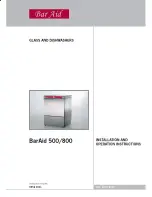
English 25
Be
for
e y
ou s
tar
t
STEP 4
Prewash (if necessary)
Select the Prewash option for the selected
course if the laundry is heavily soiled. Do
not use the Prewash option when detergent
is manually added into the drum.
STEP 5
Determine the load capacity
Do not overload the washing machine.
Overloading may cause the washing
machine to not wash properly. For the load
capacity for the type of clothing, see page
33
.
NOTE
When washing bedding or bedding covers,
the wash time may be lengthened or the
spin efficiency may be reduced. For bedding
or bedding covers, the recommended
maximum spin cycle speed is 800 rpm, and
the load capacity is 1.5~2.0 kg or less.
CAUTION
If the laundry is unbalanced and the “
UB
”
information code is displayed, redistribute
the load. Unbalanced laundry may reduce
the spinning performance.
STEP 6
Apply a proper detergent
type
The type of detergent depends on the type
of fabric (cotton, synthetic, delicate items,
wool), colour, wash temperature, and degree
of soiling. Always use “low suds” laundry
detergent, which is designed for automatic
washing machines.
NOTE
•
Follow the detergent manufacturer’s
recommendations based on the weight
of the laundry, the degree of soiling, and
the hardness of the water in your local
area. If you are not sure about the water
hardness, contact a local water authority.
•
Do not use detergent that tends to be
hardened or solidified. This detergent
may remain after the rinse cycle,
blocking the drain outlet.
•
When using powdered detergent it is
recommended that the powder should
be dissolved in warm water to ensure
optimum cleaning results.
•
When using powdered detergent it
is recommended that the powder be
dissolved in warm water to ensure
optimum cleaning results.
CAUTION
When washing wool using the wool course,
use only a neutral liquid detergent. If used
with the Wool course, powder detergent
may remain on the laundry and discolour
the laundry.
WW75J4213IW_DC68-03506P-03(v1)_EN.indd 25
2017/7/5 10:26:32
















































